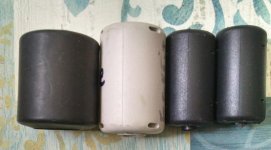ToddB64
Elite Member
Hi All !
Looking for opinions and also any general information you can offer on using a ferrite (a small ceramic shape with high-iron content) to Ground Balance a metal detector.
I saw this demonstrated recently on the Internet via a Minelab youtube for their GPZ 7000.
Then I did some investigation and discovered that there are many manufacturers of small-size ceramic ferrites of various shapes with different percentages of metals in the composition, but ferrite (iron dust) usually has the highest percent in a ceramic alloy, and possibly the largest volume of these ferrites is produced for the electronics and electrical products industries.
In addition to opinions and/or general information you might be able to offer, I would appreciate answers to the following questions if possible, but I guess these are for our science experts.
#1..Do the ingredients in the ferrite alloy, in terms of metals used and their percentages, need to be matched to the particular metal detector's frequency and/or circuit design for optimum Ground Balancing?
#2..Or is the choice of a ferrite and it's composition not that important as long as the ferrite content reigns King?
Thanks for your replies gals and guys !
ToddB64
Looking for opinions and also any general information you can offer on using a ferrite (a small ceramic shape with high-iron content) to Ground Balance a metal detector.
I saw this demonstrated recently on the Internet via a Minelab youtube for their GPZ 7000.
Then I did some investigation and discovered that there are many manufacturers of small-size ceramic ferrites of various shapes with different percentages of metals in the composition, but ferrite (iron dust) usually has the highest percent in a ceramic alloy, and possibly the largest volume of these ferrites is produced for the electronics and electrical products industries.
In addition to opinions and/or general information you might be able to offer, I would appreciate answers to the following questions if possible, but I guess these are for our science experts.

#1..Do the ingredients in the ferrite alloy, in terms of metals used and their percentages, need to be matched to the particular metal detector's frequency and/or circuit design for optimum Ground Balancing?
#2..Or is the choice of a ferrite and it's composition not that important as long as the ferrite content reigns King?
Thanks for your replies gals and guys !
ToddB64
Last edited:



